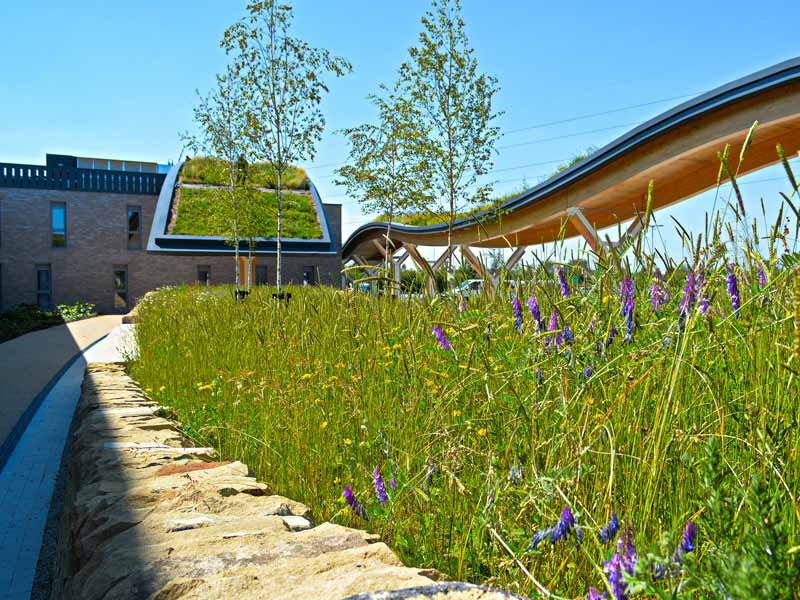In our article about establishing plants on a green roof, we mention, amongst other things, the pros and cons of using vegetation mats.
Pre-grown vegetation mats, whether they be wildflowers or sedum species are a quick and convenient way of getting the plant coverage on a green roof. But what are they and how are they produced? We’ve talked to two GRO members who are experts in the field of growing vegetation mats to find out more about what they do.
Harrowden Turf is a national grower with nationwide depots as well as arable and turf farms in East Anglia and Lancashire where alongside growing food crops, they produce turf, sedum matting, seed and wildflower products supporting horticulture professionals and the retail market.
Wildflower Turf has production units in Hampshire and in Yorkshire and are a leading innovator and advocate for landscaping and green roof products that encourage biodiversity net gain. This company is actively involved with green roof training and offers regular courses in association with the Living Roofs Academy.
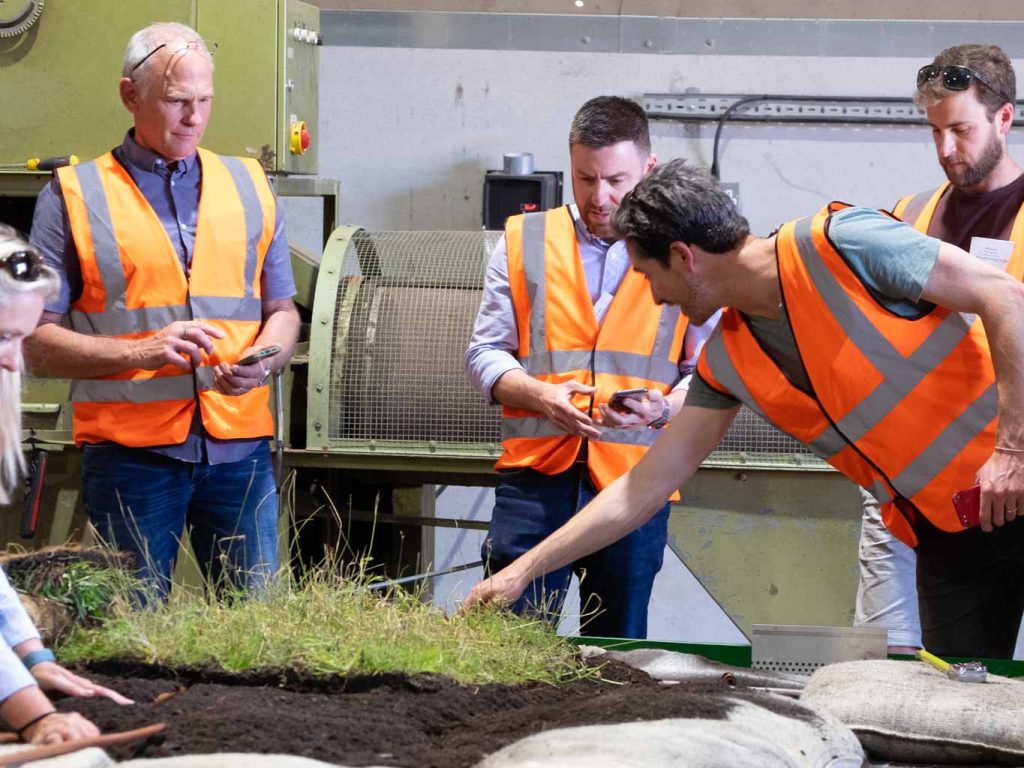
Delegates on a Wildflower Turf green roof training course learning about the best handling and establishment techniques for wildflower matting.
What Do Vegetation Mats Consist Of?
We’re not in a position to give away any trade secrets here. But in general, a vegetation mat is just like a living carpet. It usually has two components. Growing medium and plants. In some products there may be a carrier fleece to help with handling and transportation but for the most part, the mat is held together by a densely interwoven net of living roots.
The plant species mix tends to be a one-size-fits-all solution unless of course the mats have been bespoke grown for a particular project.
The Growing Process
The growing process for vegetation mats starts long before any seeds are sown. First of all, the growing area needs to be prepared.
In the case of sedum matting, drainage is of the utmost importance. Sedums hate having wet feet and will soon perish in soggy conditions. At Harrowden Turf, considerable sums of money have been invested to contour the production fields to create the ideal growing conditions for their vegetation mats.
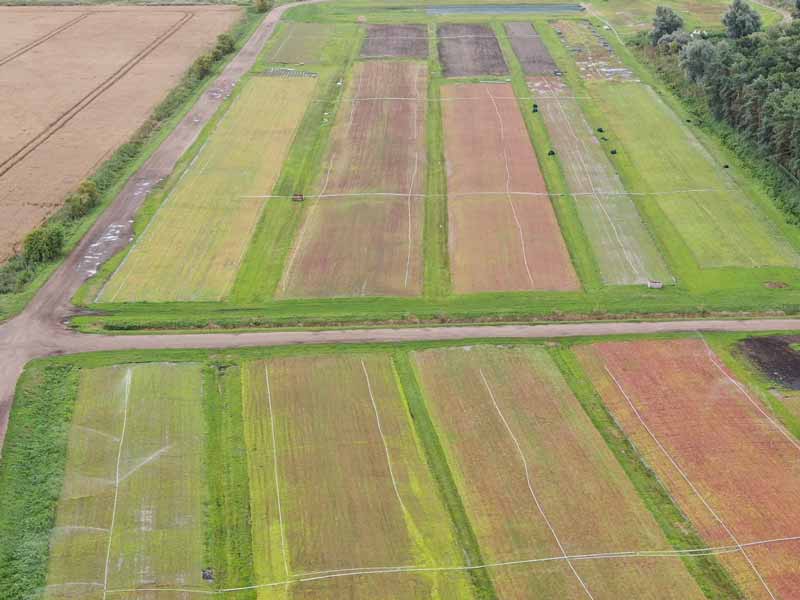
Enviromat Sedum matting production at Harrowden Turf. You can just make out the contours of the fields and can clearly see irrigation in process
Growing Medium
Growing medium is an important consideration too. It not only has to support plant life, but it must also be suitable for the intended application of the vegetation mats. The GRO Code of Best Practice talks in detail about green roof substrate which of course is completely different to topsoil.
Growers of green roof vegetation mats must either produce or import large quantities of growing medium that are free from weed seeds and compliant with GRO guidelines. Growing medium is bulky and needs specialist machinery to distribute it evenly without compacting it.
It’s important that the finished matting has exactly the right depth of growing medium. Too thin and it cannot support the developing plants; too thick and the finished product would be hard to handle and costly to transport.
The substrate needs to be nice and even too. No hills or hollows otherwise the vegetation mats will rip during harvesting and installation. That living net of roots needs to have a consistent strength throughout the product and the only way to achieve that is to have relatively even coverage of plants.
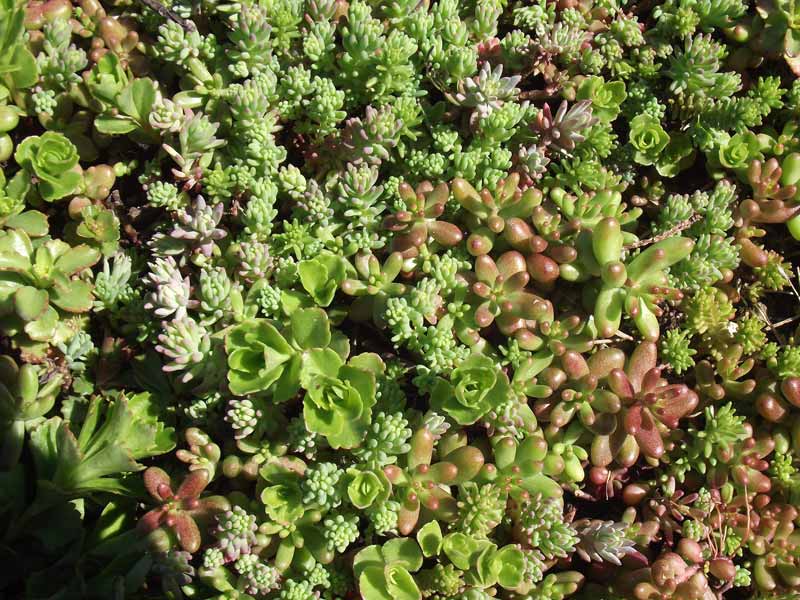
A mixture of species in vegetation matting ensures that the plant population can maintain itself in its new microclimate – the ‘happiest’ species will thrive and compensate for the plants that struggle.
Seeding Considerations
Seed mixes need careful consideration from the grower. Both vegetation mat growers we talked to have the benefit of years of experience behind them. Couple that with extensive, continuous R&D and you can be confident that their seed mixes are suitable for 99% of green roof projects. Provided of course that the roof build up is compatible with the needs of the vegetation mat chosen.
The price and availability of seed is another determining factor. It’s not unusual for growers to make small tweaks to their seed mixes each year. They want to ensure that their product is economically viable and remains in line with customer expectations.
Sedum seed in particular is difficult to handle. Each seed is almost microscopic which means it’s difficult to harvest and therefore expensive. There is no room for wastage! However, the seed resembles a fine dust – similar to talcum powder and can easily disappear on a puff of wind. So, the grower needs to pick the right day to sow it.
Wildflower seed presents a different conundrum altogether. In a mix of 30+ plant species, the variation in seed size is enormous. The grower’s challenge is to have an even mix of species across a large area of matting – it’s not easy to do!
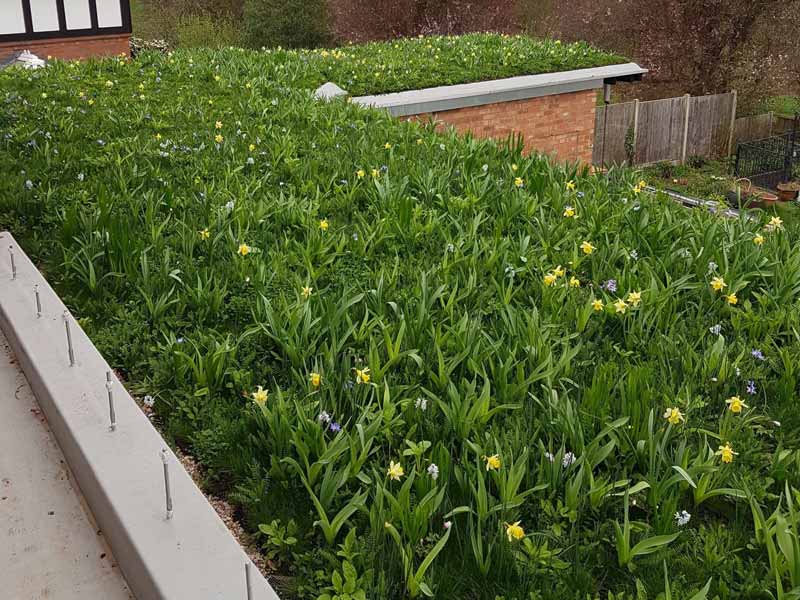
Vegetation matting is a great way to populate a green roof quickly but the species mix needn’t be restricted to what is in the pre-grown mat. This Wildflower Turf has been underplanted with spring flowering bulbs for visual interest and greater biodiversity.
Irrigation And Establishment
Root growth is restricted to a 20mm or so depth of growing medium. If roots ‘escape’ beyond this, they could be damaged during the harvesting process meaning that the green roof vegetation mats will struggle to establish on a green roof. Such a shallow root run is no problem to sedums, but the young wildflowers will need extra support to ensure that they thrive. That means specialised irrigation. Specialised because a strong jet of water could easily dislodge the young plants or wash seed off the matting. Timing, is of course crucial – particularly during warm weather. But irrigation licenses and water extraction are expensive. Our growers need to work hard to strike a balance between expenditure and the needs of their plants.
Anticipating The Unknown
As you can imagine, growing vegetation mats is, to an extent, weather dependent. Any gardener will tell you that there is an optimum time of year for sowing seeds. Normally autumn or spring. That’s when the growing medium is neither too hot nor too cold for the seeds to germinate. Getting an even coverage of seeds is a fine art.
Let’s talk about timings. Vegetation mats do not appear overnight. It can take months of careful nurturing to bring sedum matting or wildflower matting into a saleable condition. Our growers have to anticipate sales levels a good 12-18 months in advance if they are to satisfy all of their potential customers.
In Conclusion
When you are designing and specifying your living roof, spare a thought for the people who are growing the vegetation mats that will bring life to your project. Learn as much as you can about their processes and the information they need in order to help you.
If you anticipate placing an extra large order, let them know as soon as possible so that they can be sure to grow enough matting to cover your needs. Ditto for if you have a specific seed mix that needs to be custom grown.
Talk to your preferred supplier about the best way to handle, install and nurture their products and, if you can, attend training courses where you can gain hands-on experience of handling the products.
In short – form a partnership with your grower, just as you would with the suppliers of your waterproofing and other green roof components.
Further Reading
Green Roof Training days at Wildflower Turf
What Can You Grow On A Green Roof?
Inspiring The Next Generation Of Green Roofers
